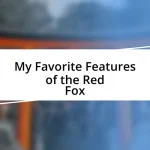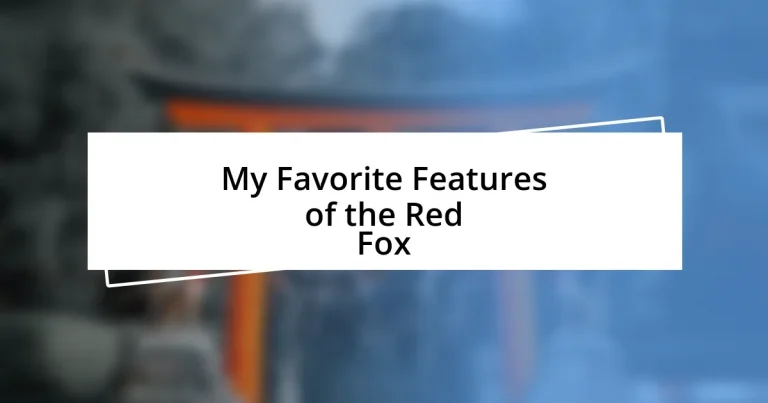Key takeaways:
- The red fox boasts a rich russet coat for effective camouflage, particularly in autumn.
- Key physical traits include pointed ears for exceptional hearing, a bushy tail for warmth and balance, and small paws for maneuverability in various terrains.
- Unique adaptations include a seasonal fur change for insulation and a flexible omnivorous diet that allows survival in diverse environments, including urban areas.
- Communication through a range of vocalizations is essential for establishing territory and social bonds among red foxes.

Introduction to Red Fox Features
When I think about the red fox, I can’t help but admire its rich, russet coat that almost gleams in the sunlight. This striking coloration isn’t just for show; it’s a vital feature that provides excellent camouflage in their natural habitats. Have you ever spotted one quietly observing its surroundings, blending seamlessly with autumn leaves?
The bushy tail, or “brush,” is another fascinating feature of the red fox. Beyond its fluffy aesthetic, this tail serves multiple purposes, such as aiding in balance and providing warmth during colder months. I remember a chilly evening when I witnessed a fox curling up, the tail wrapped around its body like a cozy blanket, showcasing just how functional this feature really is.
Additionally, their keen sense of hearing and sharp eyesight make red foxes impressive hunters. Watching a fox intently listening for the slightest rustle can be mesmerizing. Have you ever wondered how they can catch prey with such precision? It’s a blend of anatomy and instinct, truly a testament to nature’s design. Each of these features tells a part of the red fox’s story, illustrating why they captivate so many of us.

Physical Characteristics of Red Fox
The physical characteristics of the red fox make it one of the most enchanting creatures in the wild. Standing about 14 to 20 inches tall at the shoulder, these slender animals have elongated bodies, allowing them to be nimble and swift. Their pointed ears are not only adorable but also crucial for their exceptional hearing. I remember a breathtaking moment when I saw a red fox darting through a meadow, its ears perked up, listening intently to the sounds of the forest. It was as if it could hear secrets whispered by the wind.
Here are some defining physical traits of the red fox:
– Coloration: Their striking reddish-brown fur with lighter underparts and black-tipped ears creates a stunning contrast, providing effective camouflage.
– Size: Typically 18 to 35 inches long, including their bushy tail, which can add an extra foot to their length.
– Eyes: Bright, intelligent eyes vary in color from amber to dark brown, giving them an expressive and observant appearance.
– Paws: They have small, furry paws, which help them navigate in snow and maintain traction on various terrains.
– Whiskers: Long, sensitive whiskers assist them in navigating tight spaces, giving them an advantage in hunting and maneuverability.
Every time I observe a red fox, I’m reminded of the delicate balance between form and function in nature—every feature a piece of a puzzle that helps the fox thrive in its environment.

Unique Adaptations of Red Fox
The red fox’s adaptations are nothing short of fascinating, particularly its incredible ability to thrive in diverse environments. One prominent adaptation is its seasonal fur change. As the weather cools, they grow a thicker, insulating coat that helps them stay warm during winter. I once witnessed a red fox braving the cold, its thick fur fluffed up like a cozy winter jacket, and it struck me how well nature prepares these creatures for the harsh elements.
Another unique adaptation lies in their flexible diet, which allows them to flourish in urban and rural settings alike. Red foxes are omnivorous, meaning they’ll consume anything from small mammals to fruits and even scraps left by humans. I often find myself marveling at a stealthy fox rummaging through a backyard, its adaptability showcasing intelligence and resourcefulness. Have you ever considered how this versatility allows them to navigate human landscapes so seamlessly?
Lastly, the red fox’s remarkable ability to communicate plays a crucial role in their survival. They have an extensive range of vocalizations, from yips and barks to howls. I recall sitting by a campfire one night, my heart skipping a beat at the eerie yet captivating sounds coming from the woods. These vocalizations not only express emotions but also help establish territory and maintain social bonds. It’s a striking reminder of how deeply connected we are to nature and the intricate ways these creatures thrive in their wild spaces.












